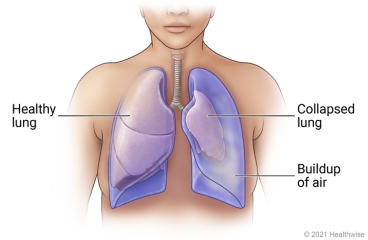Collapsed Lung: Care Instructions

Overview
A collapsed lung (pneumothorax) is a buildup of air in the space between the lung and the chest wall. The pressure of the air against the lung makes the lung collapse. Your lung cannot fully expand when you inhale. This causes shortness of breath and chest pain.
A collapsed lung is usually caused by an injury to the chest. It may also occur suddenly because of a lung illness, such as emphysema or lung fibrosis. A lung may collapse after lung surgery or another medical procedure. Sometimes it happens for no known reason.
Treatment can depend on the cause and severity of the collapsed lung. Treatment can also depend on whether the problem has returned. Some people stay in the hospital for treatment. In some cases, oxygen may be given (through a mask). It may heal with rest, but your doctor will need to check you. It can take several days for the lung to expand again. Your doctor may have drained the excess air from your chest with a needle or tube. Sometimes surgery is done to help keep the lung inflated.
The doctor will want to keep track of your progress. So you will need a follow-up exam to check your lungs. You may need further treatment if you are not getting better.
A collapsed lung may happen again. Watch for symptoms. If you have shortness of breath or chest pain, get medical treatment right away.
Follow-up care is a key part of your treatment and safety. Be sure to make and go to all appointments, and call your doctor or nurse advice line (811 in most provinces and territories) if you are having problems. It's also a good idea to know your test results and keep a list of the medicines you take.
How can you care for yourself at home?
- Get plenty of rest and sleep. You may feel weak and tired for a while, but your energy level will improve with time.
- Be safe with medicines. Read and follow all instructions on the label.
- If you are not taking a prescription pain medicine, ask your doctor if you can take an over-the-counter medicine.
- If the doctor gave you a prescription medicine for pain, take it as prescribed.
- Store your prescription pain medicines where no one else can get to them. When you are done using them, dispose of them quickly and safely. Your local pharmacy or hospital may have a drop-off site.
- If your doctor prescribed antibiotics, take them as directed. Do not stop taking them just because you feel better. You need to take the full course of antibiotics.
- If you have a bandage over your chest tube, or the place where the chest tube was inserted, keep it clean and dry. Follow your doctor's instructions on bandage care.
- If you go home with a tube in place, follow the doctor's directions. Do not adjust the tube in any way. This could break the seal or cause other problems. Keep the tube dry.
- Avoid exercise until your doctor says it's okay.
- Do not fly in an airplane or scuba dive until your doctor tells you it is okay.
- Do not smoke or allow others to smoke around you. If you need help quitting, talk to your doctor about stop-smoking programs and medicines. These can increase your chances of quitting for good.
When should you call for help?
Call 911 anytime you think you may need emergency care. For example, call if:
- You have severe trouble breathing.
- You have severe chest pain.
- You passed out (lost consciousness).
Call your doctor or nurse advice line now or seek immediate medical care if:
- You have new or worse trouble breathing.
- You have new pain or your pain gets worse.
- You cough up blood.
- Your chest tube comes out or is bent or blocked.
- You are bleeding through the bandage where the tube was put in.
- You have symptoms of infection where the tube was put in, such as:
- Increased pain, swelling, warmth, or redness.
- Red streaks leading from the area.
- Pus draining from the area.
- A fever.
Watch closely for changes in your health, and be sure to contact your doctor or nurse advice line if:
- The skin around the place where the chest tube was put in is red or irritated.
- You do not get better as expected.
Where can you learn more?
Go to https://www.healthwise.net/patientEd
Enter Q132 in the search box to learn more about "Collapsed Lung: Care Instructions".
Current as of: July 31, 2024
